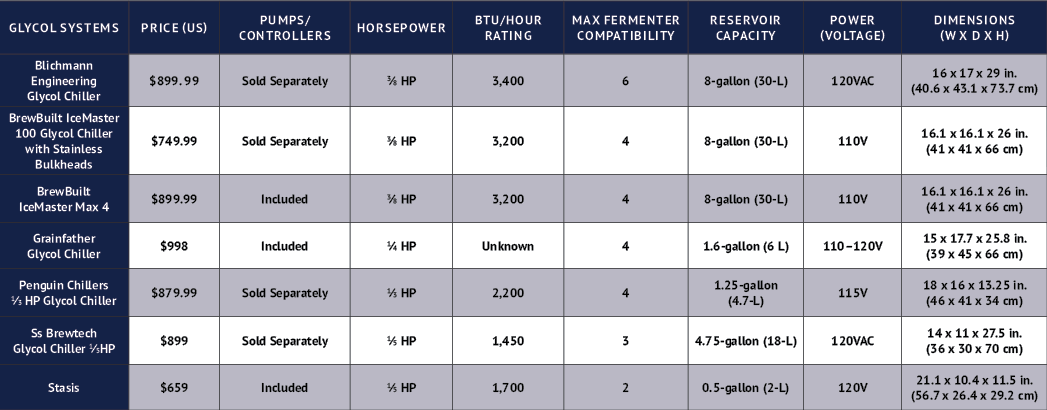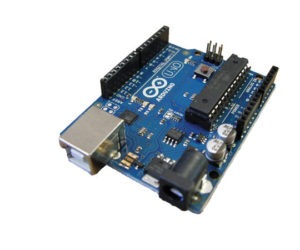Homebrew Glycol System Comparison

Everyone who brews beer knows that fermentation temperature control is one of the most critical aspects to consistent, flawless beer. When the fermentation temperature gets too warm, off flavors are sure to follow. Even if you have a cool spot in the house, daily temperature swings during fermentation can still wreak havoc on beer flavor. There are many methods homebrewers use to control fermentation temperature — from water baths and heat wraps to fermentation chambers and pumping ice water through cooling jackets or immersion coils. Each method works, to a degree, but they also have major drawbacks from having to constantly monitor the temperature and replace ice water, only being able to set one temperature for multiple batches, and space constraints, to name a few.
Over the last couple of years a new method has flooded the homebrew market: Glycol chilling systems. Similar to what is used on the professional scale, these homebrew-sized units solve nearly all of the drawbacks from other temperature control methods. Of course, the cost is greater than most of these other methods as well, so glycol cooling systems are generally intended for the more dedicated homebrewers who brew often (with multiple batches fermenting at a time) and those who brew large batches where temperature control presents greater challenges.
While each unit available offers unique features and different designs, the nuts and bolts of how glycol chillers work is simple. Fill the chiller’s reservoir up with a glycol/water mixture, which will be cooled down around freezing temperature. Then set the desired fermentation temperature on the thermostat (with some units the thermostat, as well as pumps and hoses are sold separately). A temperature probe is placed in the fermenter and whenever the temperature of the beer rises above the set temperature a pump kicks on and sends the glycol mixture through coils in or around the fermenter until it is within the correct temperature range. Additional insulation wrapped around the fermenter is often recommended to hold the temperature longer.
With multiple controllers and pumps, the ability to keep multiple fermenters at various set temperatures is also made easy. Want to lager one beer while another ferments at ale temperatures? Easy. Want to raise the temperature for a diacetyl rest on one beer but not the others? It just requires a push of a button.
Even chilling wort down to yeast-pitching temperature is made easier with a glycol chiller. Cooling those final 10–20 degrees can be difficult, especially if your tap water isn’t cold enough with a standard wort chiller. Just chill the wort down close, say to 100 °F (38 °C), then allow the glycol chiller to do the rest of the work in a fraction of the time.
There are a number of factors to consider when deciding which glycol chilling system is right for you. Is it powerful enough to get the job you need it for done efficiently? Can you control all of your fermenters with the unit? Is it in your price range? How easily compatible is it with your brewing system, and does all of the equipment you’ll require come included or will there be additional costs? Are there space constraints or aesthetic issues to be considered based on where it will be housed?
We aren’t here to tell readers which unit is the best or which you should buy. Indeed, that decision will differ depending on what each homebrewer is after. Instead, we believe there is a benefit to laying out the options in a concise way for comparisons and allowing each homebrewer in the market for a glycol unit to make an informed decision. So across the following pages we provide the manufacturer-stated specifications for seven glycol systems designed specifically for homebrewers, and put many of the key specs together side-by-side in a chart at the end of this article for easy comparison.
No matter which one you choose, the addition of a glycol system is sure to make your brewing easier. And if you haven’t already found a reliable way to ferment your beers at a set temperature, adding a glycol system will also noticeably improve the quality of your brews!
Blichmann Engineering Glycol Chiller

Just released in December 2019, the Blichmann Glycol Chiller features a 3⁄8 horsepower compressor and an 8-gallon (30-L) glycol reservoir, with an advertised 3,400 BTU/hour cooling capacity. The reservoir temperature control range is from 23 to 50 °F (-5 to 10 °C). It is compatible with up to six fermenters at a time (Blichmann FermenatorTM Pump & Controller Kits sold separately for $99.99). The unit features a convenient plug-and-play temperature controller dock and is designed to keep the cables and hoses tidy and out of the way. It also has locking casters for easy mobility.
It has the capability to cold crash six 14-gallon (53-L) fermenters at a time, or two 1-BBL fermenters. For maintaining temperatures it can handle up to six 1⁄2-BBL fermenters or four 1-BBL fermenters at a time (results based on vessels equipped with insulation at an ambient temperature of 75 °F/24 °C).
The Blichmann Glycol Chiller runs on 120VAC with a power consumption of under 500W. The unit measures 16” W x 17” D x 29” H (40.6 x 43.1 x 73.7 cm)
Web: https://www.blichmannengineering.com/glycol-chiller.html
BrewBuilt IceMaster 100 Glycol Chiller with Stainless Bulkheads

The BrewBuilt IceMaster 100 can control the temperature of up to four tanks that have a glycol jacket, added Coolstix, or submersed cooling coil/rod. The unit has a glycol reservoir capacity of 8 gallons (30 L) and has a 3⁄8 horsepower compressor. It comes with 10 stainless bulkheads with 3⁄8 OD barbs and includes wheels. A submersible pump and digital controller will need to be purchased separately (the 5-gallon/19-L BrewBuilt Chiller Pump Kit retails for $99.99 and the 10-gallon+/38-L+ kit is $109.99). Cold crashing capacity at 75 °F (24 °C) with neoprene insulation (double for fermentation temperature control) is advertised at 4+ tanks of up to 14 gallons (53 L), or up to four 1⁄2-BBL tanks, or two 1-BBL tanks.
The IceMaster 100 runs on 110V and has a cooling capacity of 950W/3,200 BTUs. The unit measures 16.1” W x 16.1” D x 26” H (41 x 41 x 66 cm).
Web: https://morebeer.com/products/brewbuilt-icemaster-100-glycol-chiller-stainless-bulkheads.html
BrewBuilt IceMaster Max 4

The newest release from BrewBuilt, the Max 4 is nearly identical to the IceMaster 100 with the exception that it includes four built-in submersible pumps with independent digital temperature controllers, allowing users to separately control the fermentation temperature or cold crashing of four tanks at a time. At just $150 more than the IceMaster 100, it delivers a significant cost savings for homebrewers who are looking to add on up to four pumps and controllers. The Max 4 has a glycol reservoir capacity of 8 gallons (30 L) and has a 3⁄8 horsepower compressor. It comes with labeled “in” and “out” stainless bulkheads with 3⁄8 OD barbs and includes wheels.
It runs on 110V (36 amps) and has a cooling capacity of 950W/3,200 BTUs. The unit measures 16.1” W x 16.1” D x 26” H (41 x 41 x 66 cm).
Web: https://morebeer.com/products/brewbuilt-icemaster-max-4.html
Grainfather Glycol Chiller

The Grainfather Glycol Chiller includes a pump with four connections to make it possible to connect and control the temperature of up to four 8-gallon (30-L) Grainfather Conical Fermenters at a time. It features a 1.6-gallon (6-L) glycol tank that has the ability to cold crash, lager, and control fermentation temperatures of up to four fermenters with 6-gallons (23 L) of wort down to 40 °F (4 °C).
The glycol chiller comes with everything needed to hook up to a single Grainfather including two 6.5-foot (2-m) insulated silicone hoses and an LED touch display. Additional cooler connection kits must be purchased separately for each additional conical fermenter (connection kits retail for $64.99 and include two 6.5-foot/2-m insulated hoses and two cooling connection couplers).
This system works with the Grainfather Conical Fermenters as the cooling sleeve is located in between the two stainless steel walls of the fermenter, which is then hooked up to the Glycol Chiller. With the chiller comes a two-part conical insulation jacket (one to wrap the body, another to wrap the cone) to insulate the conical fermenter. The unit comes with a two-year warranty.
The unit measures 15” W x 17.7” D x 25.8” H (39 x 45 x 66 cm). Electricity compatibility is 110–120V, 60 Hz.
Web: https://grainfather.com/grainfather-glycol-chiller
Penguin Chillers 1⁄3 HP Glycol Chiller

This is the smallest of a wide range of glycol chillers made by Penguin Chillers, all of which are built in America. The 1⁄3 HP model features a 5-qt. (4.7-L) glycol reservoir and can be used with up to four fermenters of any kind. It features four inlet and four outlet 3⁄8” tubing fittings on the lid of the reservoir along with an additional hole to run the power cord for each pump. Pumps, controllers, and tubing must be bought separately. Descriptions of the model indicate it runs quietly at 56 dBA. The chiller comes with a one-year warranty.
The unit weighs 48 lbs. (22 kg) and has a cooling capacity of 2,200 BTU/hour at 28 °F (-2 °C). It runs on 115V / 3.7 A / 420 W and has a 6-foot (1.8-m) power cord. It measures 18” W x 16” L x 13.25” H (46 x 41 x 34 cm)
More powerful models from Penguin Chillers are also available for homebrewers and nanobrewers, from a 1⁄2-HP unit (starting at $999.99) up to 1 HP (starting at $1,599.99).
Web: https://penguinchillers.com/product/1-3-hp-glycol-chiller
Ss Brewtech Glycol Chiller 1⁄5HP

The Ss Brewtech Glycol Chiller 1⁄5HP will maintain lager temper-atures for up to three vessels, and enable cold crash cooling for one vessel at a time. It has a 4.75-gallon (18-L) glycol reservoir with a sight glass to keep an eye on the glycol level. It integrates seamlessly with Ss FTSs kits. Since each FTSs kit includes a temperature controller, pump, and tubing, each vessel can be connected to the glycol chiller with no additional equipment necessary. However, the Glycol Chiller does not come with a controller, pump, or tubing, so those must be purchased separately if using with other vessels. It can cool up to three 7-gallon (26.5-L) conicals or unitanks, or three 10-gallon (38-L) Brite Tanks, or two 1⁄2-BBL vessels.
This unit comes with casters and measures 14” W x 11” D x 27.5” H (36 x 30 x 70 cm). It runs on 120VAC and outputs 1,450 BTUs/hour.
If you want to cool more (or larger) batches at a time, Ss also has larger units with more horsepower, including a 3⁄8-HP unit that chills up to 6 fermenters (sized from 7 gallons/26.5 L to 1⁄2 BBL) and retails for $1,295, as well as a 3⁄4-HP unit that chills up to six vessels up to 1 BBL in size, which retails for $2,495. These larger sizes pack more BTUs/hour and house larger glycol reservoirs, but generally have the same features as the 1⁄5-HP unit.
Web: https://www.ssbrewtech.com/products/glycol-chiller-1-5hp
Stasis

The Stasis from Craft A Brew is the first glycol chiller to feature internal pumps and thermostats that come standard. The Stasis can be integrated with the cooling system of any fermenter. Digital controls allow you set independent temperatures for two different beers so you can ferment two 10-gallon (38-L) batches side-by-side. The glycol tank capacity is 2.1 qts. (2 L) — which is smaller than its competitors but since it is well-insulated and moving glycol in a closed loop, it is big enough to get the job done. The minimum set temperature is 36 °F (2 °C) (keeping one beer at this temperature while fermenting a second at ale temperatures would require 5-gallon/19-L insulated fermenters).
The Stasis runs on 120V with a 1⁄5-HP compressor. It has a cooling capacity of 1,700 BTU/hour. The maximum dimensions are 21.1” W x 10.4” D x 11.5” H (56.7 x 26.4 x 29.2 cm).
Web: https://craftabrew.com/products/the-stasis-glycol-chiller



